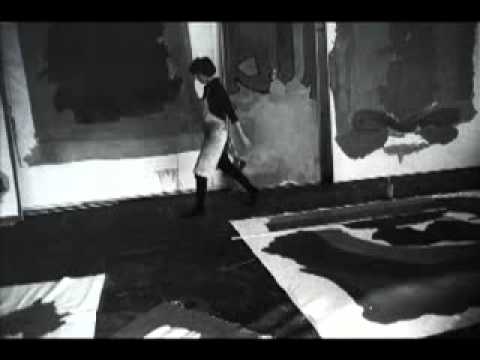Peter Jochems
You can support this channel!: https://www.patreon.com/peterjochems
Edward Hopper – Nighthawks 1942
In 1942 the American painter Edward Hopper completed this painting “Nighthawks”.
We see four people in a diner, while we are looking from outside in. It appears to be late in the evening, and the diner seems to be a beacon of light in a lonely desolate world.
Hopper said that this painting was inspired by “a restaurant on New York’s Greenwich Avenue where two streets meet”. The image however, has a universal quality.
Hopper himself said that in Nighthawks he was painting the “loneliness of a large city”. He has denied however, that he put symbols of human isolation in his paintings on purpose.
It has been suggested that Hopper was inspired by this painting done by Vincent van Gogh, from 1888, “Cafe terrace by night”. We see a similar atmosphere. People are at a terrace, under artificial light, late in the evening. We see the same green yellow colourcombination as we see in the work of Hopper.
Hopper could have seen this painting. It was exhibited around the time he was painting Nighthawks. Hopper even exhibited with his own paintings together with the Van Gogh before. But apart from these circumstances and the similarities in atmosphere and tone, there is no evidence he was inspired by it.
In a journal Hopper kept notes about his paintings. He wrote that he named his painting Night Hawks and he finished it on january 21,1942
His wife Josephine added more detail in her writing in the journal
This is what she wrote.
Night + brilliant interior of cheap restaurant. Bright items: cherry wood counter + tops of surrounding stools; light on metal tanks at rear right; brilliant streak of jade green tiles 3/4 cross canvas at base of glass of window curving at corner. Light walls, dull yellow ocre [sic] door into kitchen right. Very good looking blond boy in white (coat, cap) inside counter. Girl in red blouse, brown hair eating sandwich. Man night hawk (beak) in dark suit, steel grey hat, black band, blue shirt (clean) holding cigarette. Other figure dark sinister back at left. Light side walk outside pale greenish. Darkish red brick houses opposite. Sign across top of restaurant, dark Phillies 5c cigar. Picture of cigar. Outside of shop dark, green. Note: bit of bright ceiling inside shop against dark of outside street at edge of stretch of top of window.
The notes Josephine writes read like an objective description to instruct a director what a certain movie scene should look like. Apart from the mention of the sinister appearance of the man that we see on the back, there is no mention of the feelings the painting evokes. If this matter of fact description is a reflection of how Hopper approached the painting process, and it might well be, than it only contributed to the desolate atmosphere that arises from the painting.
Hopper made several drawings as a preparation of the painting.
This drawing shows us the whole scene, We can already see all the motives. It is however, not as tightly structured as the painting eventually turned out to be.
In a sketchy manner he studies the various details
This is a study for the sinister looking man that we see on the back.
Here we see him studying the main structure of the composition.
We see how he places the buildings.
Here he studies the lighting of the scene.
The paintings derives it’s effect mostly from the sense of space it creates. When we look at the earlier drawing we can see all the motives, but it doesn’t have the desolate effect yet. The feeling of alienation isn’t as strong. When I look at the drawing I feel I could move a little to the right where there must be a door somewhere, so I can enter the scene myself.
On the painting Hopper gives the side walk, on which we supposedly walk and from which we look inside, a more prominent appearance. It is as if we are already destined to walk past the diner on the side walk, and there is no door along the path we will walk.
The viewpoint of the drawing gives us the option to turn left or right, The painting suggests we already have determined to walk into the direction that we are looking at, passing the diner along the way. We would actually have to change our logical course of action to enter the diner.
When we look at Norman Rockwell’s painting from 1958, “the runaway”, also situated in a diner, we see an endearing little scene. A scene which could be far more sinister if the painter wasn’t someone who made his images innocent and sentimental captures of small town American life.
Hopper’s vision has nothing sentimental. It’s this emptiness of feeling, this lack of narrative and communication among the figures which characterizes this diner as part of modern life in a big city. A place to drown your feelings for a moment, to forget about daily life and to have one more drink before returning home, or whatever place you will spend the night.
Source



Maybe the little detail of you talking without music made this video so comfortable to watch.
Bedankt. Ik heb deze al jaren aan de muur hangen. Blijf er naar kijken.
Buenísimo. Una maravilla. Muchas gracias por compartir sus conocimientos.
Sometimes, one must take what artists' says about their paintings with a pinch of salt. It is often said that artists always reflect the times in which they are painting. Hopper, whether consciously or unconsciously appears to have captured the "isolationist" atmosphere and individualist ideal of the times. Being part of a group or collective was liable to have one labeled a communist. Interesting that the female wears red clothing. Modern art was rejected because of its 'foreignness' it was not American. Its not the viewer that is isolated here but the figures in the painting. The red, white and blue of each of their clothing brings to mind nationalism because of its symbolic reference to the colours of a flag.